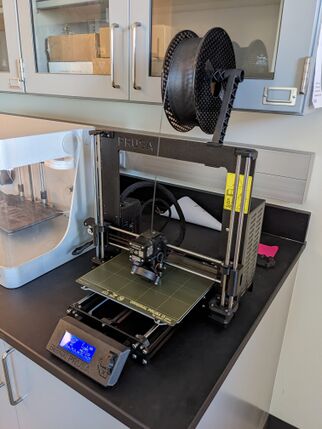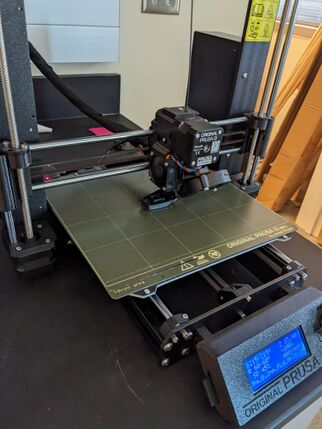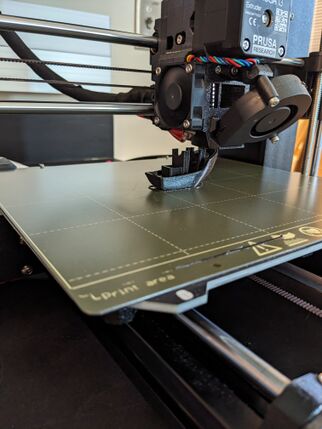Material extrusion: Difference between revisions
No edit summary |
|||
| Line 2: | Line 2: | ||
== Process Description == | == Process Description == | ||
Material extrusion is the most common form of additive manufacturing technology | Material extrusion is the most common form of additive manufacturing technology. This method works by melting or softening the material, and combining it to old layers to produce a part. In fused filament fabrication, also known as fused deposition modeling (FDM), the model or part is produced by extruding small beads or streams of material that harden immediately to form layers. | ||
Filament is fed from a large spool through a moving, heated printer extruder head, and is deposited on the growing work. The print head is moved under computer control to define the printed shape. Usually the head moves in two dimensions to deposit one horizontal plane, or layer, at a time; the work or the print head is then moved vertically by a small amount to begin a new layer. The speed of the extruder head may also be controlled to stop and start deposition and form an interrupted plane without stringing or dribbling between sections. | Filament is fed from a large spool through a moving, heated printer extruder head, and is deposited on the growing work. The print head is moved under computer control to define the printed shape. Usually the head moves in two dimensions to deposit one horizontal plane, or layer, at a time; the work or the print head is then moved vertically by a small amount to begin a new layer. The speed of the extruder head may also be controlled to stop and start deposition and form an interrupted plane without stringing or dribbling between sections.[[File:PXL 20230914 182737949.jpg|right|frameless|429x429px]] | ||
[[File:PXL 20230914 182737949.jpg|right|frameless|429x429px]] | |||
== Strengths & Weaknesses == | == Strengths & Weaknesses == | ||
The benefits of material extrusion include: | The benefits of material extrusion include: | ||
* '''Budget-friendly:''' material extrusion technology has been around long enough that plenty of reasonably priced printers. these will fulfill the needs of people who are interested in getting into printing. | |||
* ''' | * '''Ease of use:''' material extrusion has advanced to a point where it is easier to use than some 2d printers. Also, if there is a problem there is an unprecedented amount of free online information to help. | ||
* ''' | |||
The drawbacks of material extrusion include: | The drawbacks of material extrusion include: | ||
* '''Surface finish:''' because of the way that parts are created layer lines will almost always be visible. this will especially be an issue anywhere where support is needed. | |||
* '''Need for support:''' material extrusion can find it difficult to print parts with intense overhangs, so they often need to add extra material to give a stable platform for printing. these can be removed but it does use the material and will affect the surface finish. | |||
* '''Warping:''' temperature differences can cause uneven contractions in a part while it's printing leaving a warped part. this can be helped with a heated bed and proper enclosure. | |||
[[File:PXL 20230914 185334611.jpg|right|frameless|429x429px]] | |||
== Printing Properties (needs new name) == | == Printing Properties (needs new name) == | ||
| Line 48: | Line 42: | ||
== Technologies == | == Technologies == | ||
There are a number of specific technologies that can vastly change to capabilities of a printer. | There are a number of specific technologies that can vastly change to capabilities of a printer. | ||
'''Metal replacement''' (Bound metal deposition/Atomic diffusion) | '''Metal replacement''' (Bound metal deposition/Atomic diffusion) | ||
Revision as of 08:27, 3 October 2023
Process Description
Material extrusion is the most common form of additive manufacturing technology. This method works by melting or softening the material, and combining it to old layers to produce a part. In fused filament fabrication, also known as fused deposition modeling (FDM), the model or part is produced by extruding small beads or streams of material that harden immediately to form layers.
Filament is fed from a large spool through a moving, heated printer extruder head, and is deposited on the growing work. The print head is moved under computer control to define the printed shape. Usually the head moves in two dimensions to deposit one horizontal plane, or layer, at a time; the work or the print head is then moved vertically by a small amount to begin a new layer. The speed of the extruder head may also be controlled to stop and start deposition and form an interrupted plane without stringing or dribbling between sections.
Strengths & Weaknesses
The benefits of material extrusion include:
- Budget-friendly: material extrusion technology has been around long enough that plenty of reasonably priced printers. these will fulfill the needs of people who are interested in getting into printing.
- Ease of use: material extrusion has advanced to a point where it is easier to use than some 2d printers. Also, if there is a problem there is an unprecedented amount of free online information to help.
The drawbacks of material extrusion include:
- Surface finish: because of the way that parts are created layer lines will almost always be visible. this will especially be an issue anywhere where support is needed.
- Need for support: material extrusion can find it difficult to print parts with intense overhangs, so they often need to add extra material to give a stable platform for printing. these can be removed but it does use the material and will affect the surface finish.
- Warping: temperature differences can cause uneven contractions in a part while it's printing leaving a warped part. this can be helped with a heated bed and proper enclosure.
Printing Properties (needs new name)
| Low | High | |
|---|---|---|
| volume X/Y/Z (mm) | 120/68/150 | 1005/1005/1005 |
| resolution (mm) | .25 | 1 |
| layer height (um) | 20 | 300 |
| price ($) | 200 | 27,475 |
Technologies
There are a number of specific technologies that can vastly change to capabilities of a printer.
Metal replacement (Bound metal deposition/Atomic diffusion)
Metal particles are infused into a thermal plastic. The printed part is put through a secondary process to remove the thermal plastic leaving a smaller metal part in its place.
Continuous fiber reinforcement
A Second print head lays down fiber into the internal structure of a print. This gives the part stronger material properties


